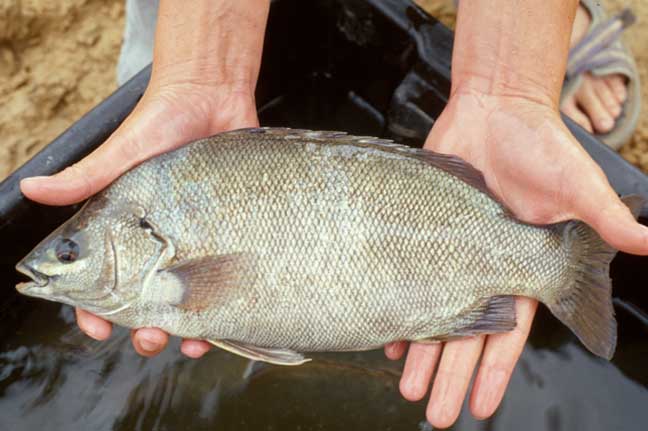Barcoo Grunter, Scortum barcoo (McCulloch & Waite 1917)

Barcoo Grunter, Scortum barcoo. Source: Michael Hammer. License: all rights reserved
Barcoo Grunter, Scortum barcoo (McCulloch & Waite 1917)
More Info
|
Distribution |
Known only from scattered localities in central Australia of NSW, NT, QLD and SA. A temperate to tropical species inhabiting turbid water of large freshwater rivers and waterholes; tolerant of water temperatures to 40ºC. |
|
Features |
Meristic features: Dorsal fin XIII, 12; Anal fin III, 8; Petoral fin 16; Pelvic fin I, 5. Body moderately deep, 2.1 in SL, ovate, compressed; dorsal profile convex from nape to origin of dorsal; about as pronounced as ventral profile, head almost flat above; ventral profile straight from lower lip to pelvic insertion; then curved to anus. Head length 3.2 in SL. Snout pointed, length 3.7 in HL. Nostrils with free cutaneous edges separated by a distance slightly greater than diameter of posterior nostril. Eye width 4.8 in HL. Interorbital region flat, with bony ridges. Jaws equal; gape oblique; maxillary reaching to vertical through posterior nostril; teeth minute; outer series little enlarged, subcardiform, slightly depressible; vomer with 3-4 small teeth in middle; palatines without teeth. Lacrimal serrate posteriorly. Preoperculum serrate; largest serrations on angle. Lower opercular spine longer and stronger; not extending beyond edge of opercular flap. Post-temporal exposed; serrate along posterior edge. Cleithrum exposed; serrate; scales on side. Supracleithrum exposed. Scales finely ctenoid; lateral line continuous, smoothly curved; scales counted in a series above lateral line to hypural base; 70 scales counted in a series below lateral line to hypural base; scales above lateral line; two rows of scales in sheath at base of dorsal fin, sheath extending to tenth dorsal ray; 2-4 rows of scales in sheath at base of anal fin, sheath extending across base of entire fin; cheek scales in 7-8 rows; 73-80 in longitudinal series above lateral line. Dorsal fin continuous; spinous portion arched; fifth spine longest, 2.0 in HL, those following decreasing in length to ultimate; longest dorsal spine longer than longest dorsal rays; soft dorsal rounded. Second anal spine longest, 2.2 in HL; shorter than longest anal rays; soft anal rounded. Pectoral fins asymmetrically pointed; fifth ray longest. Ventral fins inserted behind vertical through first dorsal spine; first ray longest, reaching a little more than half distance to anus. Caudal fin emarginate. |
|
Size |
To 35 cm SL, commonly to 25 cm. |
|
Colour |
Silvery-grey sides, darker dorsally and whitish ventrally. Usually with irregular black blotches laterally which can be flashed on and off and may vary daily in position and number. Fins transparent or whitish with a bluish tinge. Eye reddish below which a white stripe extends to snout. |
|
Feeding |
Omnivore- feeds on fishes, crustaceans, insects and molluscs. |
|
Biology |
Oviparous, producing demersal eggs opportunistically during flood events. |
|
Etymology |
The generic name Scortum, Latin for leather or hide, refers to the leathery texture of the flesh of members of this genus. |
|
Species Citation |
Therapon barcoo McCulloch & Waite, 1917, Trans. R. Soc. S. Aust. 41: 474. Type locality: Coopers Creek, SA. |
|
Author |
Martin F. Gomon |
Barcoo Grunter, Scortum barcoo (McCulloch & Waite 1917)
References
Allen, G.R., Midgley, S.H. & Allen, M. (2002). Field guide to the freshwater fishes of Australia. Perth : Western Australian Museum 394 pp.
Larson, H.K. & Martin, K.C. (1990). Freshwater Fishes of the Northern Territory. Northern Territory Museum of Arts and Sciences Handbook Series Number 1. Darwin : Northern Territory Museum of Arts and Sciences 102 pp. 73 figs.
McCulloch, A.R. & Waite, E.R. (1917). Results of the South Australian Museum expedition to Strzelecki and Coopers Creeks; Pisces. Trans. R. Soc. S. Aust. 41: 472–475 figs 1–2
Vari, R.P. (1978). The terapon perches (Percoidei, Terapontidae) a cladistic analysis and taxonomic revision. Bull. Amer. Mus. Nat. Hist. 159(5): 175–340 figs 1–94.
Wager, R. & Unmack, P.J. (2000). Fishes of the Lake Eyre catchment of central Australia. Department of Primary Industries Queensland Fisheries Service 88 pp..

